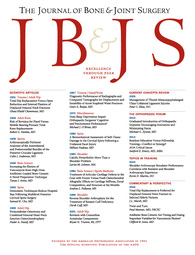
ARTHROPLASTY
Total Knee Arthroplasty with Use of Computer-Assisted Navigation in Asian Patients
J Bone Joint Surg Am. 2011 Jul 6;93(13):1197-202113 elderly Asian patients with bilateral knee osteoarthritis (OA) and genu varus deformity were randomized to receive either computer-assisted total knee arthroplasty or conventional total knee arthroplasty. Each patient received treatment on both knees with each intervention being performed on separate knees. Randomization occurred on the basis of operative technique and which treatment was preformed first. Post-surgery radiographic analysis revealed that patients with preoperative mechanical axis deviations of greater than 20 degrees were significantly closer to normal axes after computer-assisted surgery in comparison to the conventional approach. Additionally, knees from the computer-assisted group had restoration of the mechanical axis within 3 degrees.
Unlock the full ACE Report
You have access to {0} free articles per month.Click below to unlock and view this {1}
Unlock NowCritical appraisals of the latest, high-impact randomized controlled trials and systematic reviews in orthopaedics
Access to OrthoEvidence podcast content, including collaborations with the Journal of Bone and Joint Surgery, interviews with internationally recognized surgeons, and roundtable discussions on orthopaedic news and topics
Subscription to The Pulse, a twice-weekly evidence-based newsletter designed to help you make better clinical decisions
Exclusive access to original content articles, including in-house systematic reviews, and articles on health research methods and hot orthopaedic topics
Or upgrade today and gain access to all OrthoEvidence content for just $1.99 per week.
Already have an account? Log in


Subscribe to "The Pulse"
Evidence-Based Orthopaedics direct to your inbox.
{0} of {1} free articles
Become an OrthoEvidence Premium Member. Expand your perspective with high-quality evidence.
Upgrade Now












































































